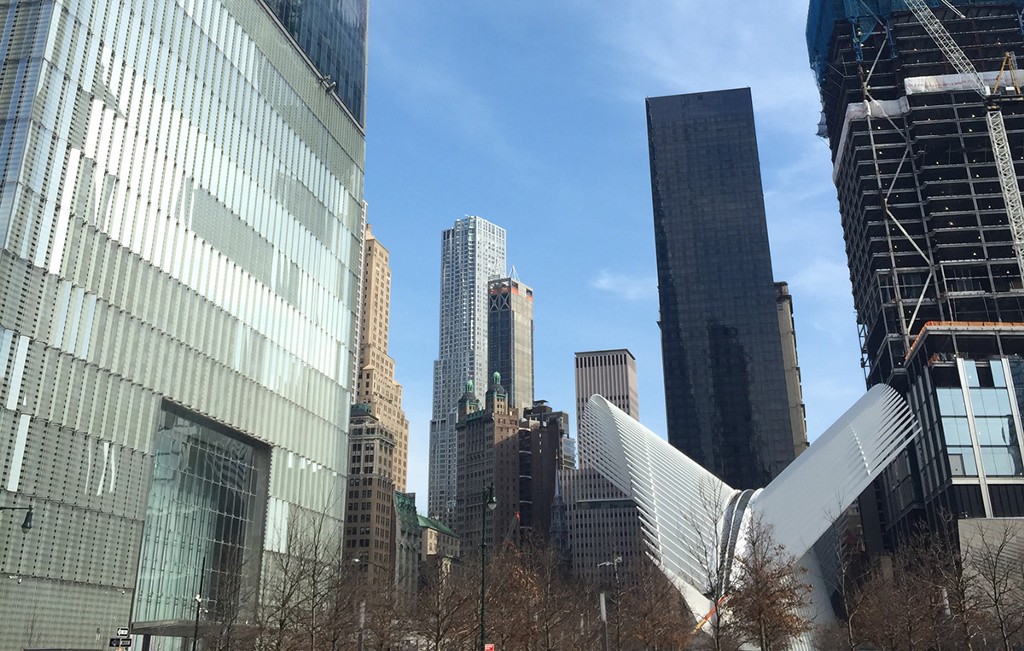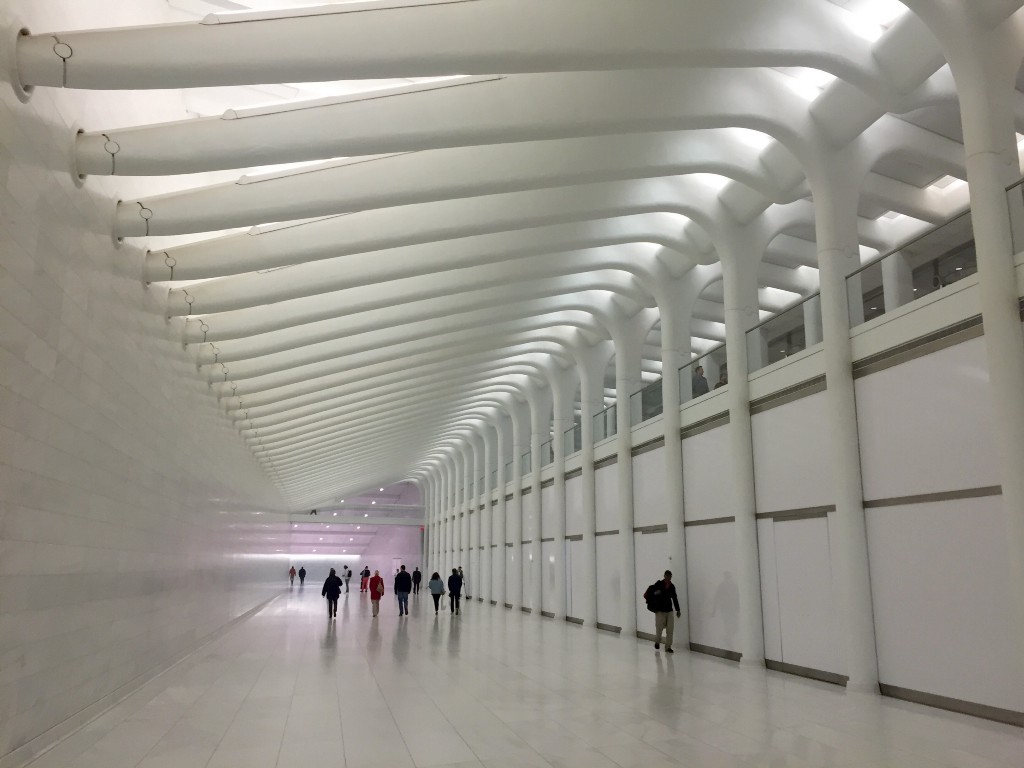The Downtown Void
by Brendan O’Connor

Earlier this month, the new World Trade Center Transportation Hub opened to the public, seven years late and almost two billion dollars over budget. And it’s still not completely finished. Most recently, it was delayed by water leaks. Meanwhile, adjacent to the Hub’s swooping white spires, the erstwhile Two World Trade Center is looking for a major tenant to replace News Corp and 21st Century Fox, which unexpectedly backed out of a 1.3-million-square-foot deal a few months after it was announced with an intensely coordinated media campaign. The building, designed by Bjarke Ingels, looks like a precariously organized stack of boxes. “My first reaction was, ‘Wow, this building looks like it’s going to topple. It’s going to fall over,’” developer Larry Silverstein said during a panel last month. Perhaps, devoid of an anchor tenant, it will.
According to New York, when redevelopment of the World Trade Center and its immediate surroundings is complete, and all of the buildings find tenants, some one hundred thousand people will commute to work there. The Hub, which is run by the Port Authority of New York and New Jersey, includes a PATH station for commuters from New Jersey. (In January, the WTC PATH station served just under fifty thousand commuters daily — not significantly more than the far more humble station at 33rd Street.) The Hub is meant to inspire visions of a bird in flight — at the 2004 unveiling of his plans, architect Santiago Calatrava, sketched a girl releasing a dove. At its center lies a massive, open space, plunging one-hundred-sixty feet below street level to an open ovoid that measures three hundred and ninety-two feet long and a hundred and forty-four feet wide. The fifty-six thousand-square-foot floor of the Oculus, lit from above by a twenty-two-foot-wide window that stretches from one end to the other, is completely empty, “as functionally vapid inside as it is outside,” writes the New York Post’s real estate, restaurant, and architecture critic Steve Cuozzo. The Port Authority plans to use the Oculus as an event space. Presumably, when it does so, commuters will just have to…walk around the event?

Administrative costs alone on the project have exceeded $655 million, the New York Times reported in 2014, and even the Port Authority is feeling some buyer’s remorse. “We would not today prioritize spending $3.7 billion on the transit hub over other significant infrastructure needs,” executive director Patrick Foye said. Times architecture critic Michael Kimmelman recently deemed the cost overrun “unconscionable.” (On the other hand, New York magazine reports, “The cost of beauty is often high.”) Calatrava, the artist, seems to think that those overly concerned with price tags are missing the point, pointing to universally beloved Grand Central Station, instantly lauded as “the greatest station, of any type, in the world” upon its opening in 1913. “Think about the person who was living in the suburbs 100 years ago, when this building opened. They enter here inside and see all these stone details, all these lamps, all these mirrors,” Calatrava told New York’s Andrew Rice last year. “You could say it is a luxury of the railway, but it is not true. This was a gift.”

Well, yes, Grand Central was a gift, in the sense that the city didn’t pay for it — the Vanderbilts did — and it cost about half as much as the Hub has cost, adjusting for inflation. That is all to say nothing of the development its construction stimulated in the immediate area; the Financial District, on the other hand, which has received more than $30 billion in public and private investment in the past decade, probably needs no further stimulation. But perhaps, as Calatrava implies, to fixate on the base, material concerns of how much it costs to build a train station is misguided: Downtown Manhattan’s real transit hub is Fulton Center, which recently completed its own pricey refurbishment.
Fulton Center, controlled by the MTA, lies a few blocks east, serving nine subway stops and three hundred thousand people daily. It and the Hub are connected by a three-hundred-fifty-foot tunnel, and also by the company that controls all of the retail space in both locations: the Australian mall operator Westfield, which, just a few months before the September 11 terror attacks, signed a ninety-nine-year lease on the retail portion of what would become Ground Zero. The sprawling Hub-Fulton Center labyrinth will function as much as a mall as a train station: Westfield expects the hundred and twenty-five different retailers ringing the Oculus to do between $700 million and $1 billion in annual sales. Businesses moving into the Hub will include Apple, H&M, Michael Kors, Victoria’s Secret, Kate Space, and Daniel Boulud. (The significantly higher-end Brookfield Place, a couple blocks to the west, houses Gucci, Equinox, and Hermes. Also, a Parm and a Black Seed Bagel, where, on Wednesday, I had a tuna melt; it was fine.) But, as I have reported previously, Westfield’s expertise is not only in working with retailers and restaurants, but also in creating Dynamic Brand Experiences From Morning Till Night and “delivering one-of-a-kind value propositions by creating ‘Complete Brand Experiences’ and ‘Domination Packages’ allowing brands to govern an entire visual landscape with style and sophistication.” Its strength is in “its ability to connect consumers with the best brands, creating communications that lead to a relationship,” according to one promotional video, which promises to make the World Trade Center into “the most alluring retail landmark in the world.”
As hectic as the World Trade Center has become again, as much building as has gone on, as towering and bright as 1WTC is, there is hardly a place in New York City so full of absence. This is the core idea of the 9/11 Memorial, after all: Water slipping continuously away and out of sight into a pair of bottomless chasms. (Bottomless, that is, at least so far as we can see from our place on the edge.) The memorial’s quietly commemorative emptiness is contrasted, now, with the roaring vacuum at the heart of the Hub, which, despite the architect’s avian aspirations, resembles nothing so much as the half-buried, sun-bleached ribcage of some forgotten behemoth — its center one more void, ringed with retail, that can never be filled.
